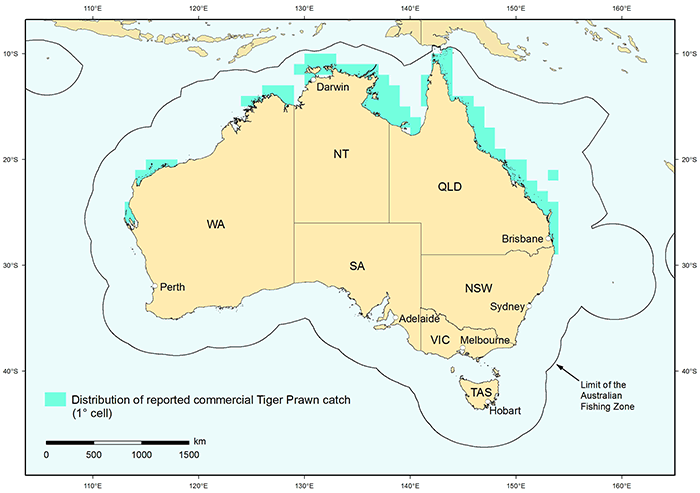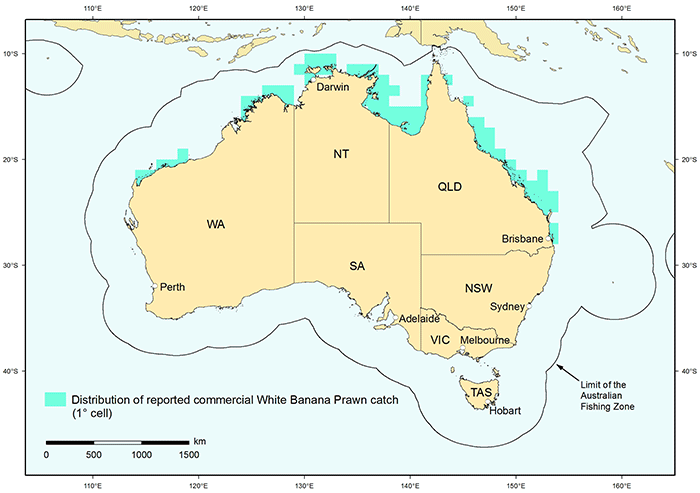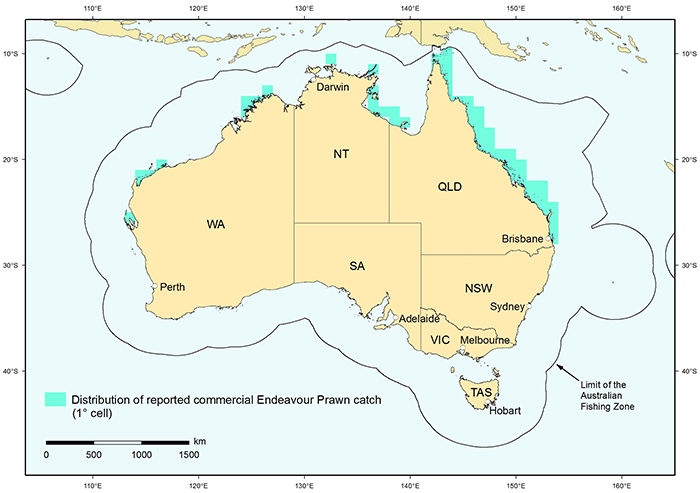Banana prawns have a light, sweet flavour.
Banana prawns are more commonly used in hot dishes rather than in cold salads or platters.
Tiger prawns are large and flavoursome and are often the choice of top hotels and restaurants. Endeavour prawns are small and have a mild-to-strong tasty sweetness.
Download our species guide on common species caught in AFMA managed fisheries.
Scientific name: Penaeus esculentus, P. semisulcatus
Family: Penaeidae
Other names:
- P. esculentus: Brown tiger prawn
- P. semisulcatus: Grooved tiger prawn, green tiger prawn, northern tiger prawn
Description: Brown tiger prawns are generally brown with dark banding. Their rostrum and antennae are also banded. Grooved tiger prawns are dark green to dark brown, with darker banding on the abdomen, legs, antennae and rostrum. Unlike brown tiger prawns, grooved tiger prawns have a distinct groove in the postrostral ridge.
Size (length and weight): Usually 11‑20 cm in length and 35‑50 grams. Grooved tiger prawns are slightly smaller than brown tiger prawns. Females grow larger than males.
Life span: Up to 2 years.
Habitat: Tiger prawns inhabit coastal waters to depths of 200 metres. Adult brown tiger prawns are found over coarse sediments. Adult grooved tiger prawns are found in fine mud sediments. Juveniles tiger prawns are found in shallow waters, often in association with seagrass beds, and sometimes on top of coral reef platforms.
Prey: Molluscs, crustaceans and polychaete worms. Feeding occurs mostly at night.
Predators: Squid, cuttlefish, and a variety of demersal fish. Juveniles are also preyed on by barramundi and catfish.
Reproduction: Tiger prawns reach reproductive maturity at about 0.5 years of age. Spawning occurs throughout the year, in both inshore and offshore areas for brown tiger prawns and in offshore areas for grooved tiger prawns. Brown tiger prawns have a spawning peak between July and October. Grooved tiger prawns have a spawning peak in in August-September, with a secondary peak in February. Mating occurs during moulting, with the male implanting a spermatophore (sperm package) into the female’s spermatheca (sperm storage organ). Eggs are shed into the water after moulting and are fertilised externally by sperm from the spermatheca. Females produce about 186 000 eggs (brown tiger prawns) and 365 000 eggs (grooved tiger prawns) per year depending on their body size. Eggs hatch within 24 hours of fertilisation.
Scientific name: Penaeus indicus and Penaeus merguiensis
Family: Penaeidae
Other names:
- P. merguiensis: White banana prawn, Gulf banana prawn
- P. indicus: Redleg banana prawn, Indian banana prawn
Description: Banana prawns are large prawns. The body is translucent white to yellow with tiny reddish-brown spots. White banana prawns have cream to yellow legs and redleg banana prawns have pink or red legs.
Size (length and weight): Up to 25 cm in length and 75 grams. Commonly found at 14‑17 cm in length and 20‑30 grams. Redleg banana prawns are slightly smaller than white banana prawns. Females grow larger than males.
Life span: Up to 1.5 years.
Habitat: Banana prawns inhabit tropical and subtropical coastal waters. They are found over muddy and sandy bottoms in coastal waters and estuaries. Juveniles inhabit small creeks and rivers in sheltered mangrove environments. White banana prawns can generally be found at depths of 16‑25 metres but can occur to depths of 45 metres. Redleg banana prawns are found at depths of 35‑90 metres. Banana prawns are a schooling species. They sometimes form extremely dense aggregations near the surface that are called ‘boils’.
Prey: Small bivalve molluscs, crustaceans, polychaete worms, and foraminifera.
Predators: Fish such as blue-spot trevally and barramundi, sharks and rays.
Reproduction: Banana prawns reach reproductive maturity at about 0.5 years of age. Although spawning occurs in shallow coastal waters throughout the year there are two spawning peaks: the late dry season (September-November) and the late wet season (March-May). Mating occurs during moulting, with the male implanting a spermatophore (sperm package) into the female’s spermatheca (sperm storage organ). Eggs are shed into the water after moulting and are fertilised externally by sperm from the spermatheca. Banana prawns are serial spawners and each female can lay several egg batches each year. Females produce 100 000‑450 000 eggs per year depending on their body size. Eggs hatch within 24 hours of fertilisation.
Scientific name: Metapenaeus endeavouri, M. ensis
Family: Penaeidae
Other names:
- M. endeavouri: Blue endeavour prawn
- M. ensis: Red endeavour prawn, false endeavour prawn, greasyback prawn
Description: Endeavour prawns have pale brown to pink bodies with either a bright blue (blue endeavour prawn) or bright red (red endeavour prawn) edge on the tail fin. The legs are pink to red. Blue endeavour prawns have three pairs of conspicuous movable spines on the telson (the sharp, triangular spike at the end of the abdomen).
Size (length and weight): Commonly found at 7‑14 cm in length and 22‑30 grams. Can grow up to 20 cm in length. Red endeavour prawns are slightly smaller than blue endeavour prawns.
Life span: Up to 2 years.
Habitat: Endeavour prawns inhabit tropical coastal waters. Blue endeavour prawns can be found over sandy or mud-sand substrates to depths of about 60 metres. Red endeavour prawns prefer muddy substrates and have been found to depths of 95 metres. Juveniles blue endeavour prawns are commonly associated with seagrass beds in shallow estuaries, while juvenile red endeavour prawns are more widely distributed across seagrass beds, mangrove banks, mud flats and open channels.
Prey: Small crustaceans, molluscs, polychaete worms and foraminifera.
Predators: Squid, cuttlefish and a variety of demersal species.
Reproduction: Endeavour prawns reach reproductive maturity at about 0.5 years of age. Spawning occurs throughout the year. Blue endeavour prawns have spawning peaks in March and September. Red endeavour prawns have a spawning peak in September ‑ December. Mating occurs during moulting, with the male implanting a spermatophore (sperm package) into the female’s spermatheca (sperm storage organ). Eggs are shed into the water after moulting and are fertilised externally by sperm from the spermatheca. Females produce about 296 000 eggs per year depending on their body size. Red endeavour prawns may be more fecund than blue endeavour prawns.
| Species | Fishery found in | Gear used | Catch of this species is targeted or incidental |
|---|---|---|---|
| Tiger prawn | Northern Prawn Fishery Torres Strait Prawn Fishery |
Bottom trawl | Targeted |
| Banana prawn | Northern Prawn Fishery | Bottom trawl | Targeted |
| Endeavour prawn | Northern Prawn Fishery Torres Strait Prawn Fishery |
Bottom trawl | Targeted |
AFMA manages prawn catches by putting rules around the size and number of nets (and sometimes boats) fishers use, and where and when they can fish. There are different rules about what fishing gear can be used in each fishery. We also limit how many boats can fish in each fishery and close areas to fishing to protect important habitats, such as nursery grounds.
Fishers help us to monitor how many prawns are caught by filling in logbooks. This information along with other research information is reviewed by resource and management advisory groups to assess how much fishing can occur within the fishery and ensure its continued sustainability.
Tropical prawn species are mainly found in tropical and sub-tropical waters around Australia. They occur from Shark Bay in Western Australia along the Northern Territory and Queensland coastlines (including waters in Torres Strait between Australia and Papua New Guinea) and midway down the New South Wales coast.
Tiger prawns

Banana prawns

Endeavour prawns

Prawns are caught in our fisheries using bottom trawl nets (also called otter trawls). Fishers in the Northern Prawn Fishery use either two, three or four trawl nets. Fishers in the Torres Strait Prawn Fishery usually use four nets.
Prawns are also caught in some state managed commercial fisheries using similar types of trawl gear.
Sometimes, bottom trawling can catch unwanted species of fish. This is known as bycatch and it is monitored by on-board fishery observers.
While it is not physically possible to trawl on coral reef, other sensitive habitats such as seagrass beds could be damaged from trawling. Most of these areas are protected by being closed to fishing. These areas are monitored through satellite tracking devices.
AFMA aims to minimise the effects that fishing for prawns has on the environment by assessing the risks and developing management responses. We work with the Department of the Environment to ensure that our fisheries meet strict environmental guidelines.
AFMA manages the risks for each fishery differently depending on the impacts and types of fishing gear. Some management responses include gear restrictions and modifications, area closures and mechanical devices to eliminate or reduce bycatch. Ecological risk assessments and management reports are available for each fishery.
The Northern Prawn Fishery also gained Marine Stewardship Council certification in November 2012. This means the fishery meets the highest international standards for environmental sustainability.
Gear
Want to know more?
This is just an overview of prawns, if you want to know more see the links below.
These species are managed under the Northern Prawn Fishery and the Torres Strait Prawn Fishery.